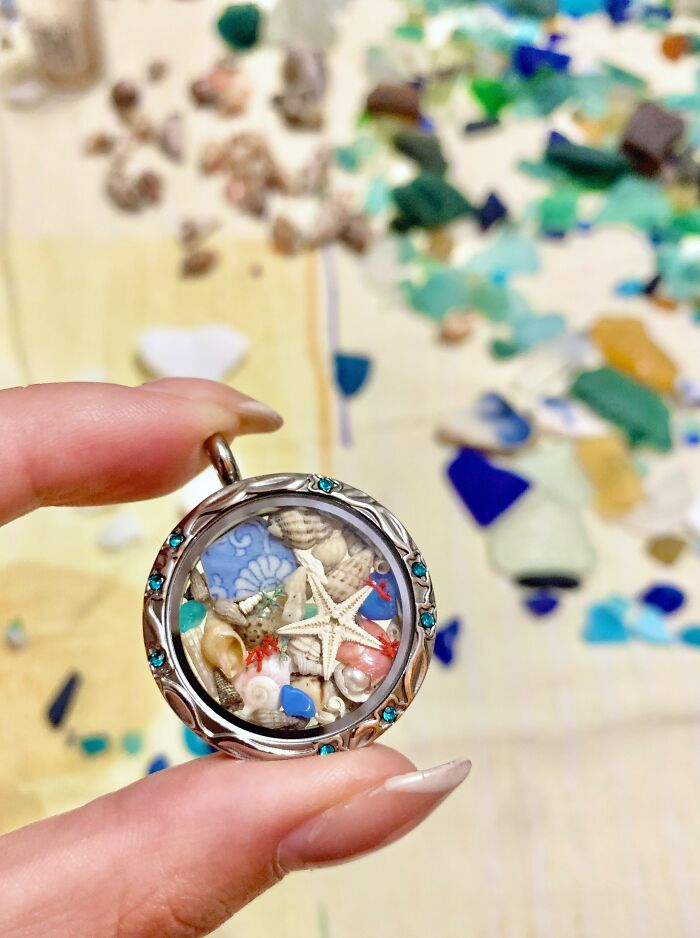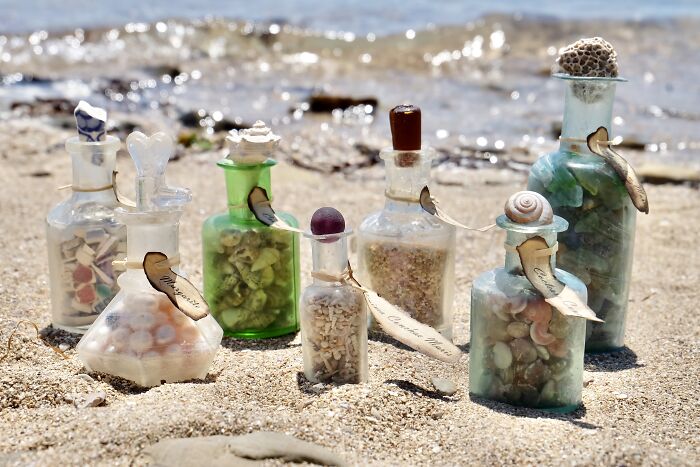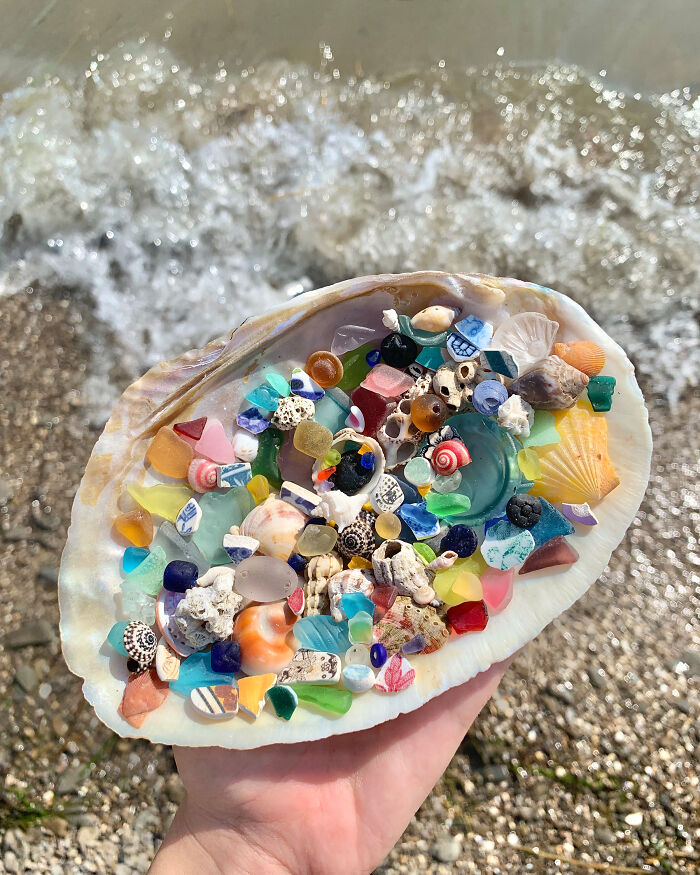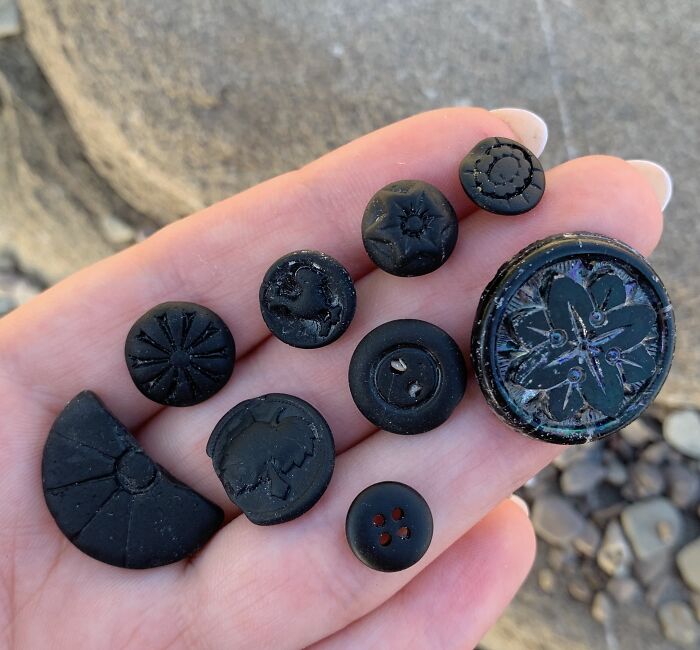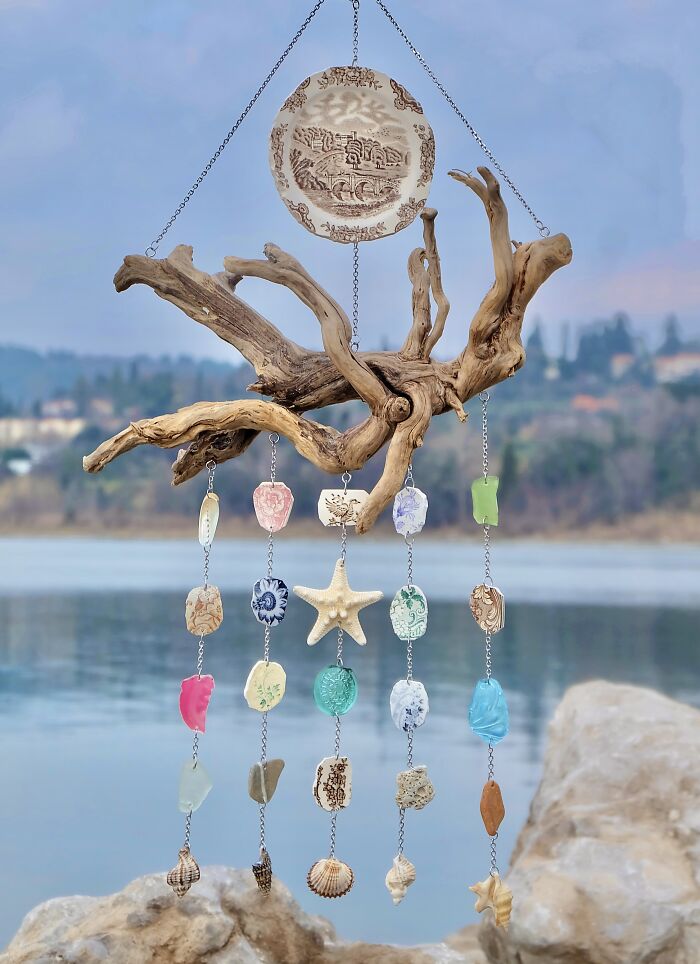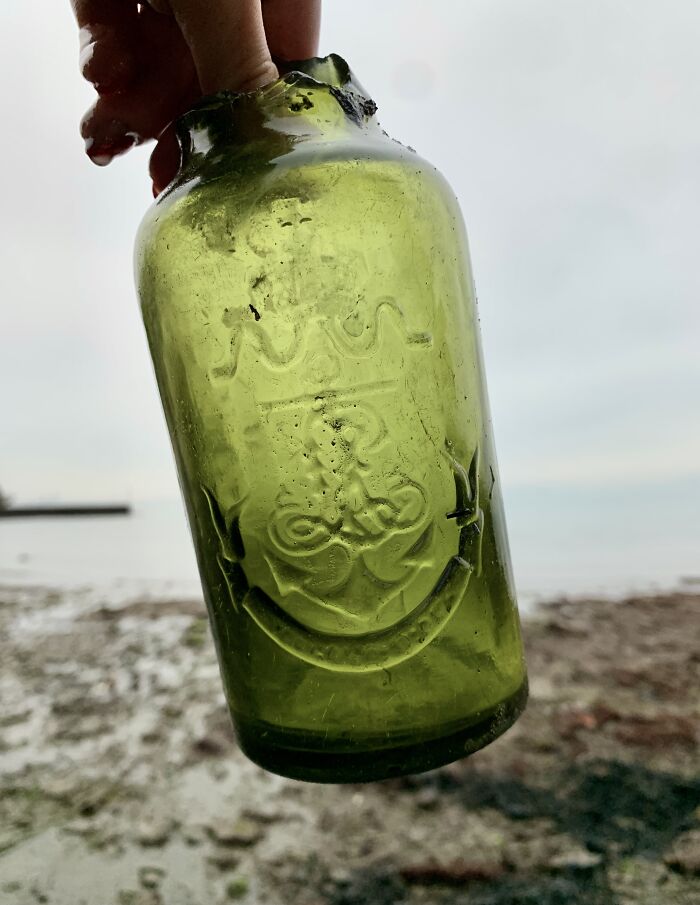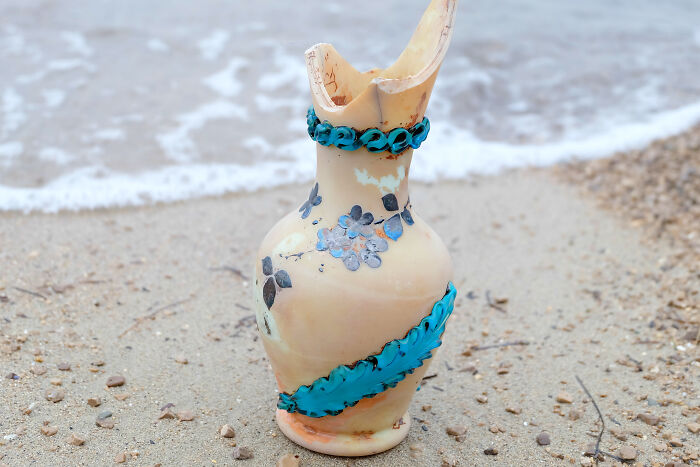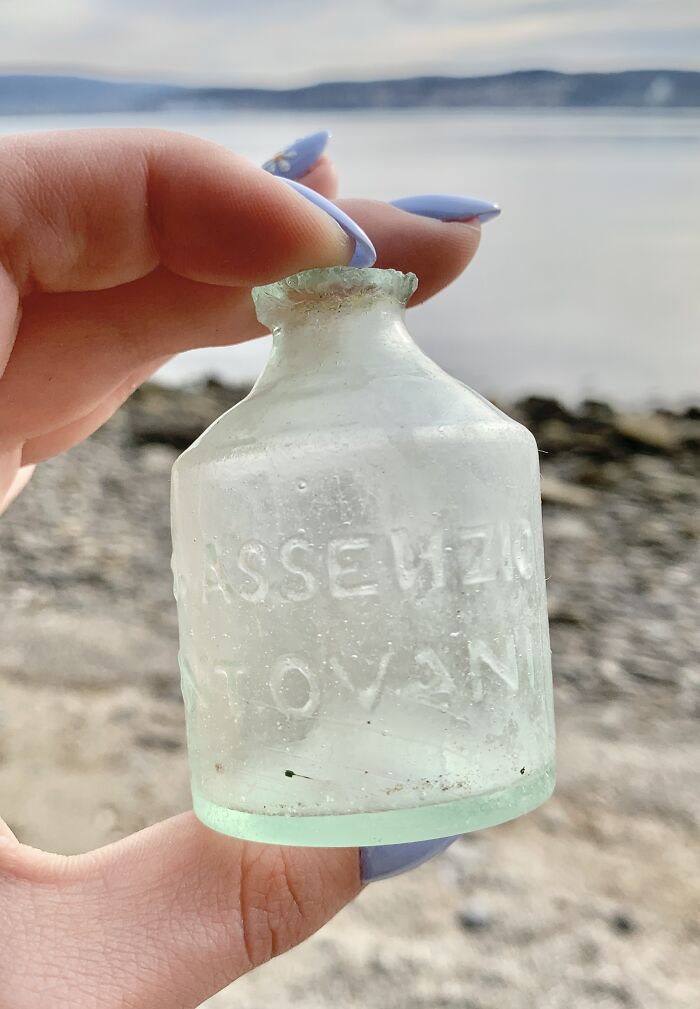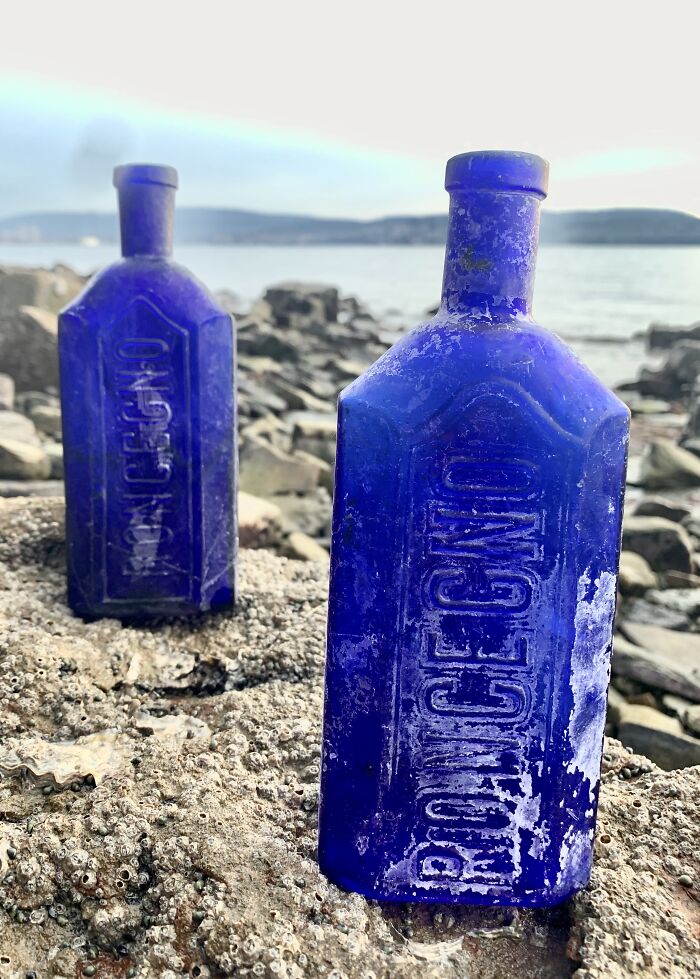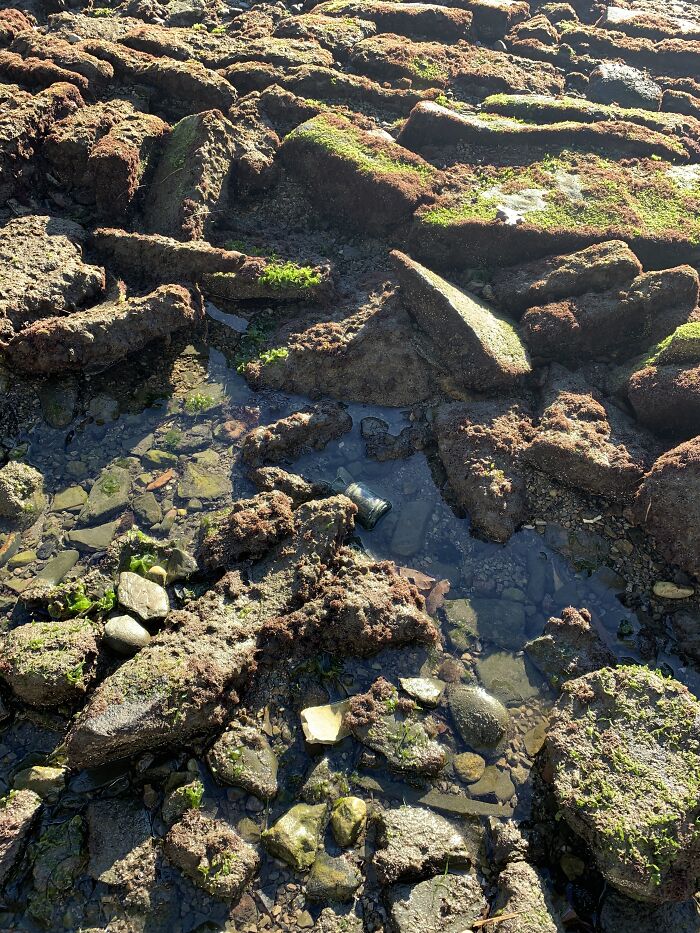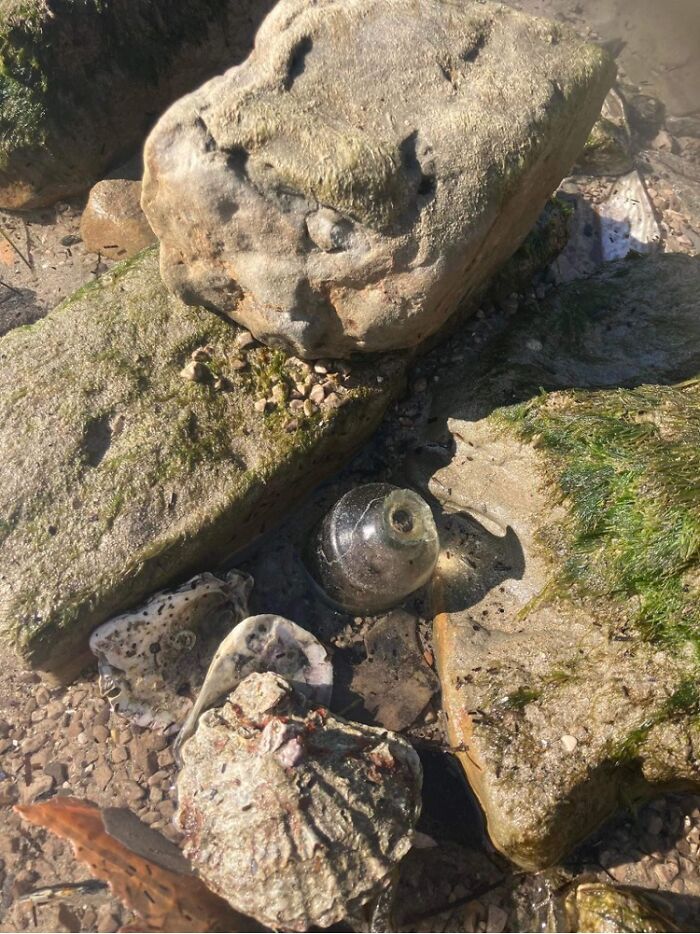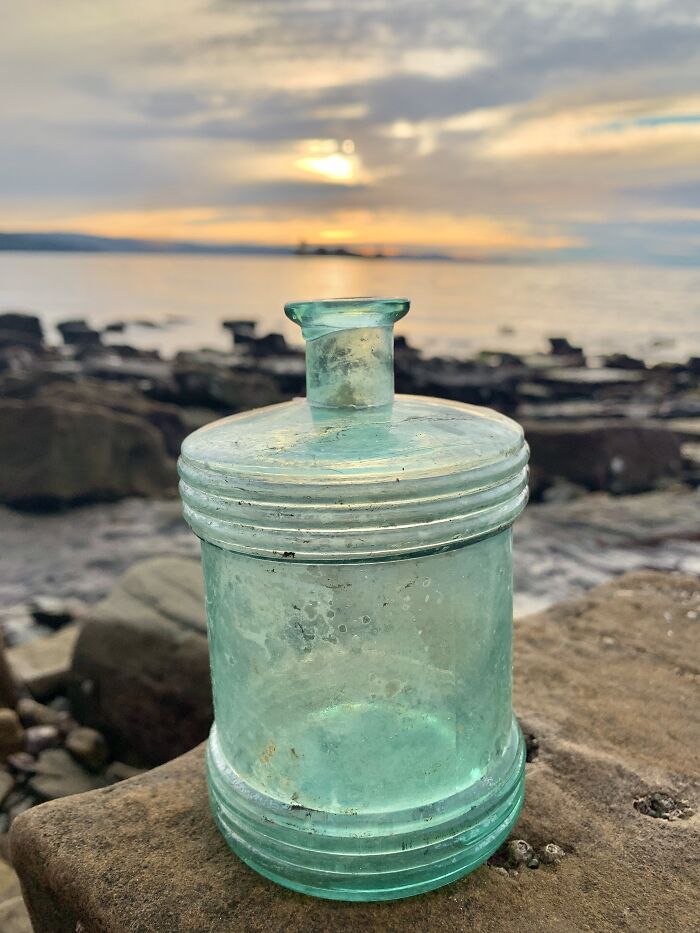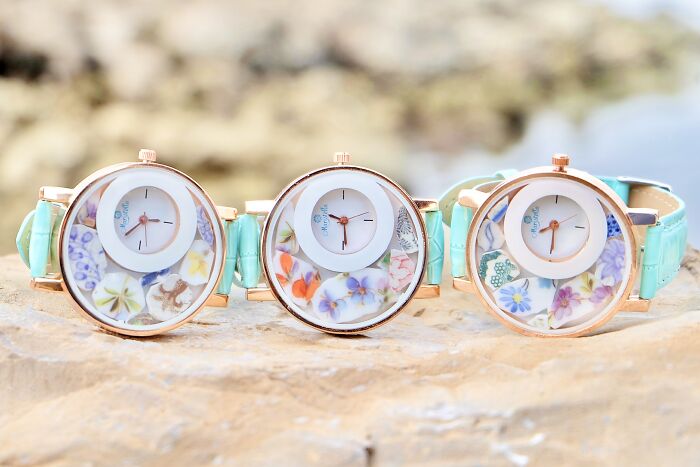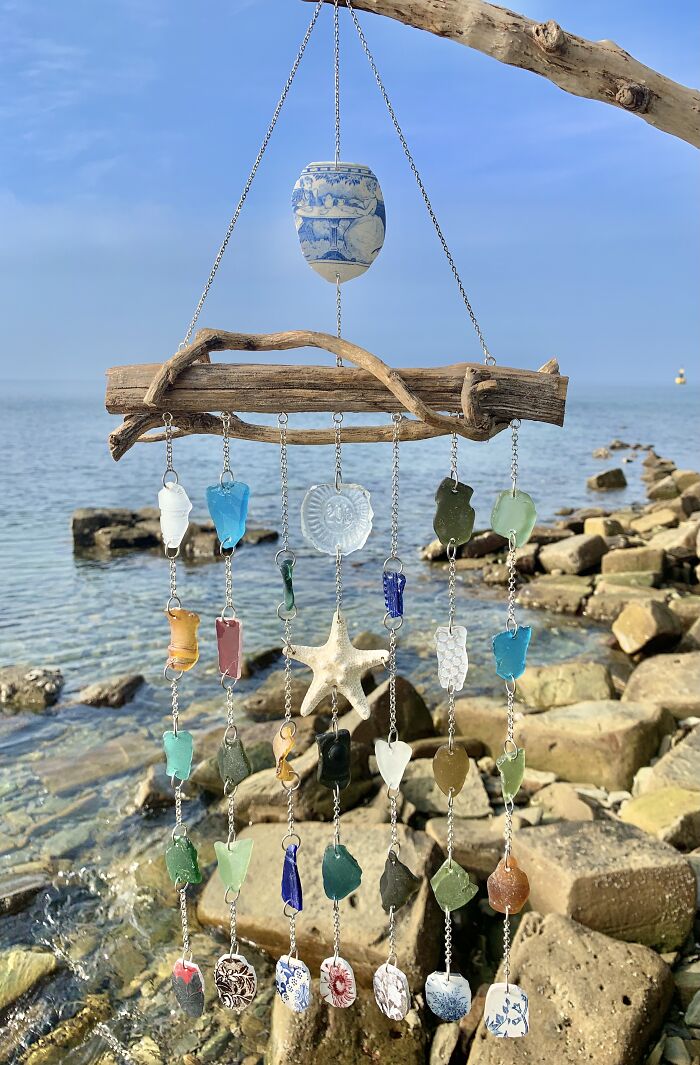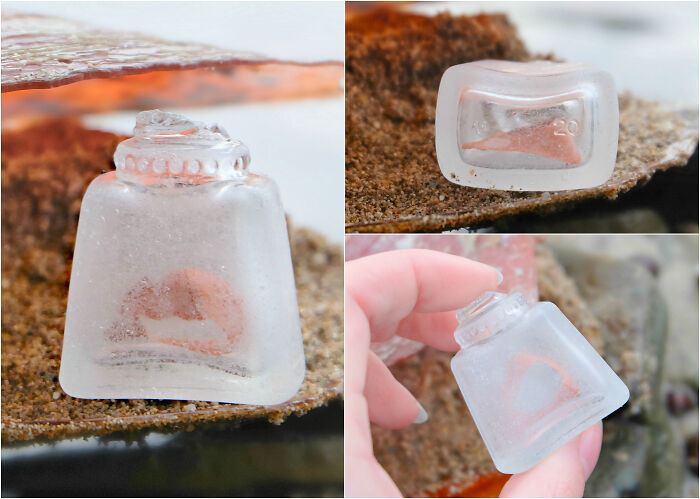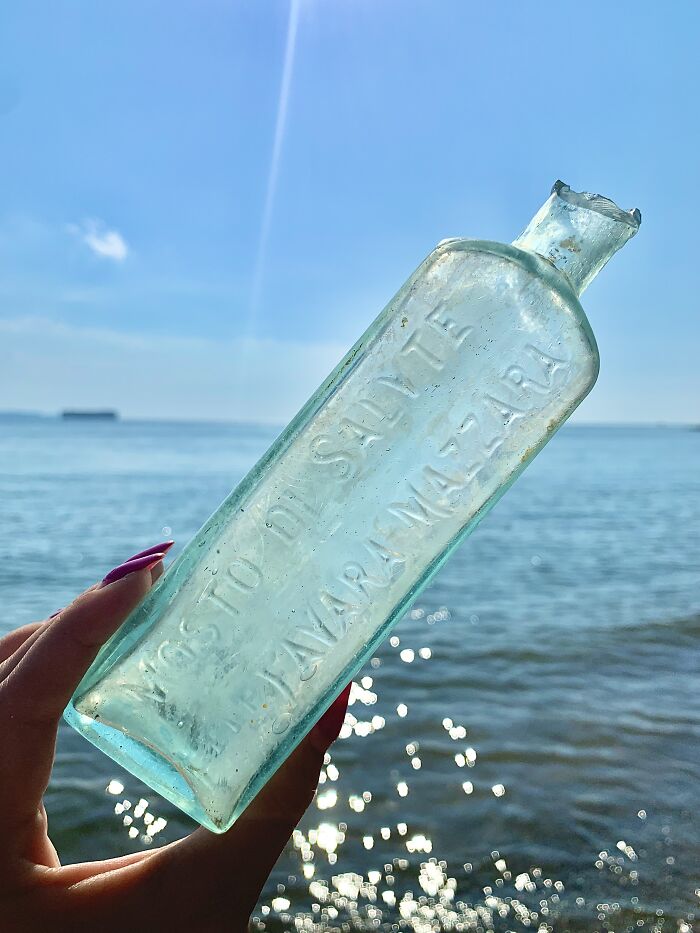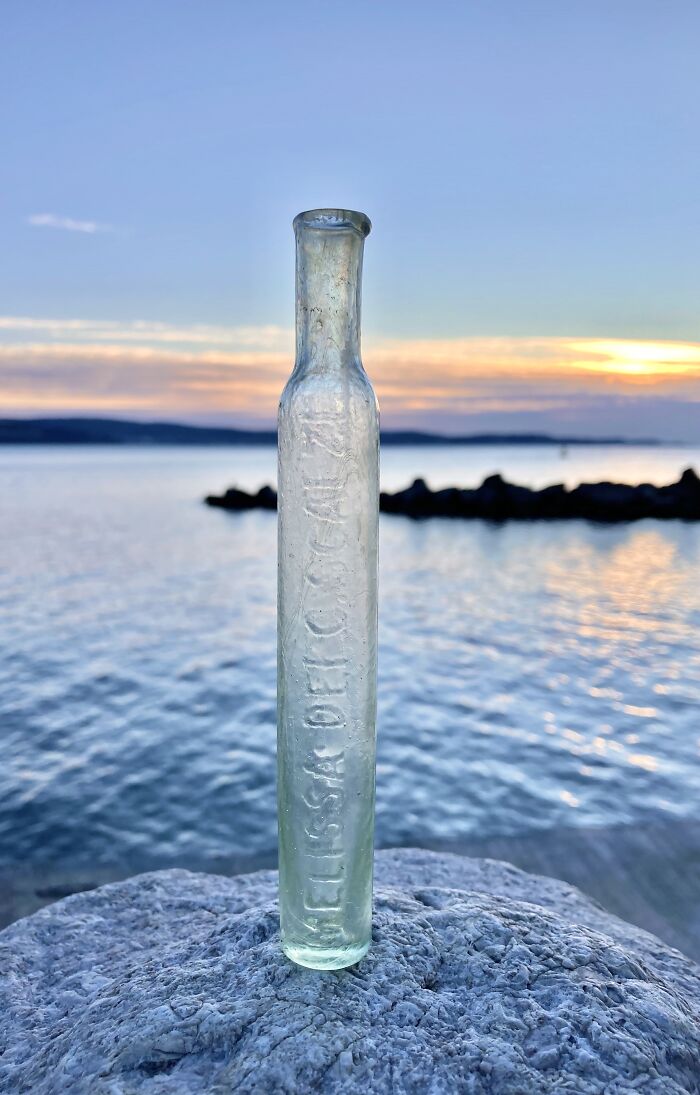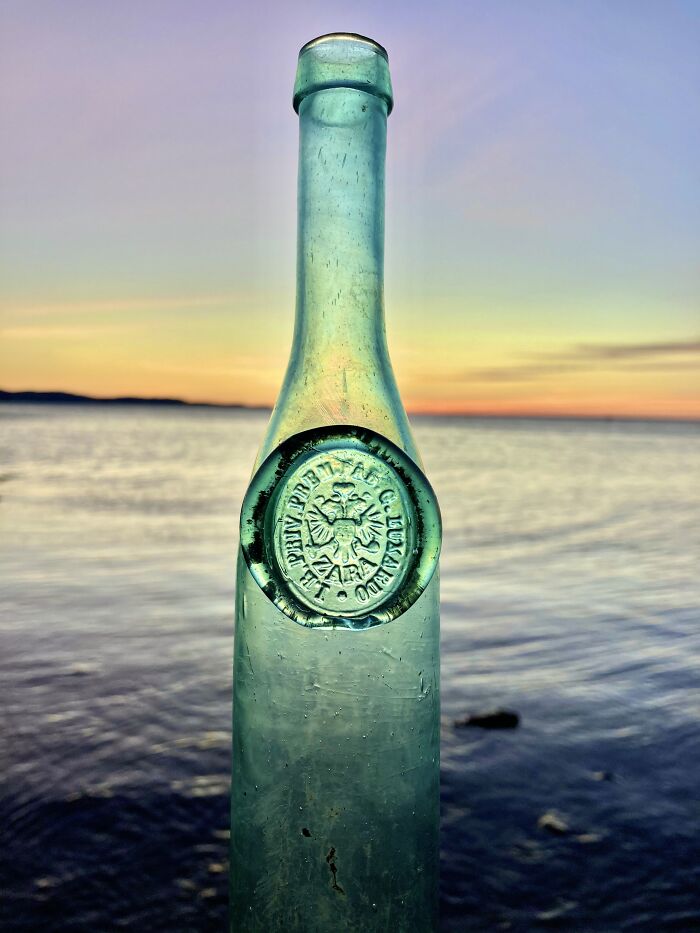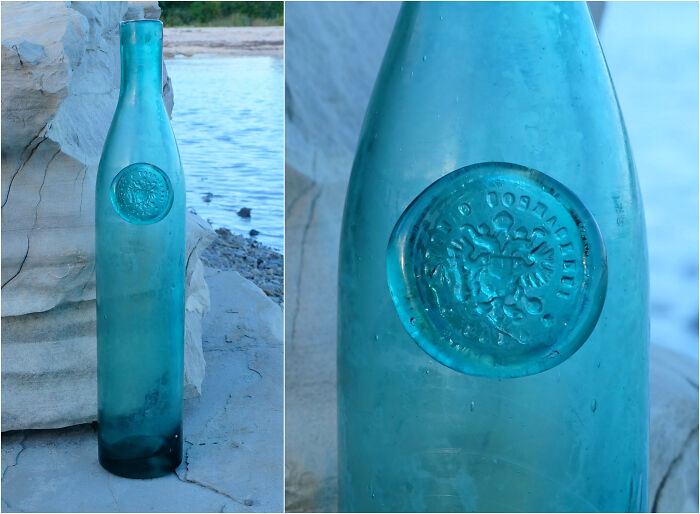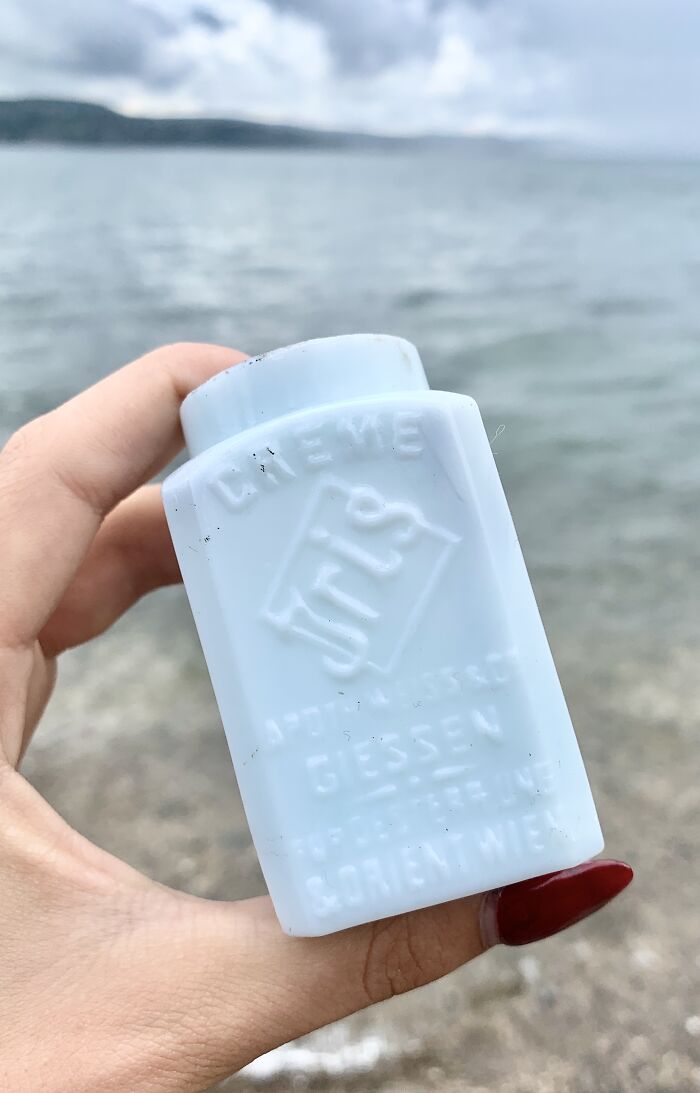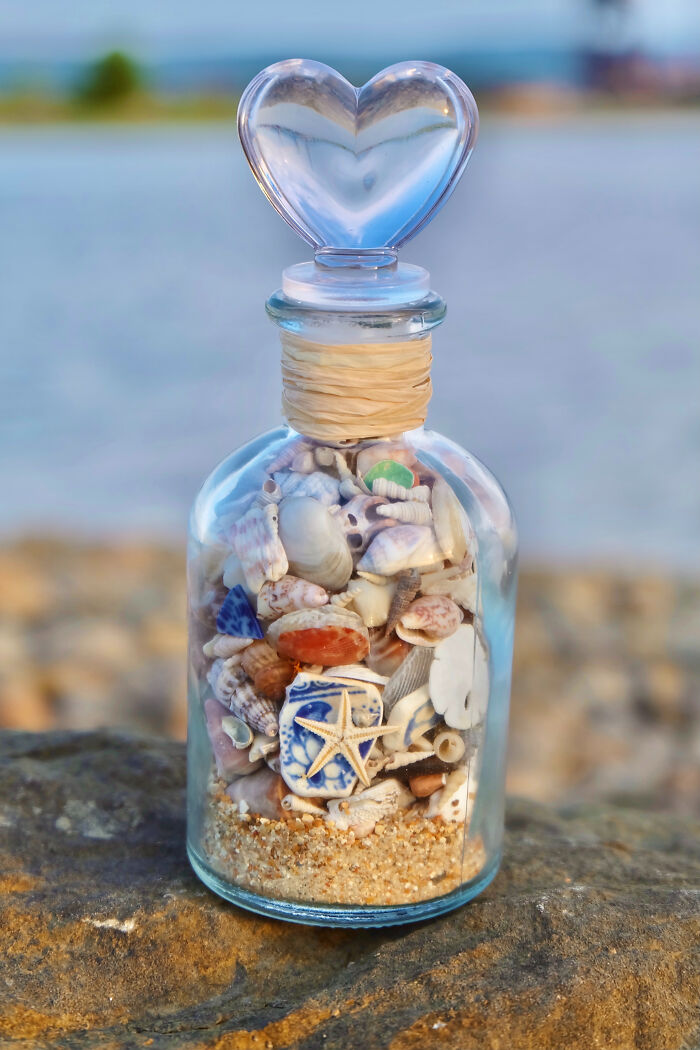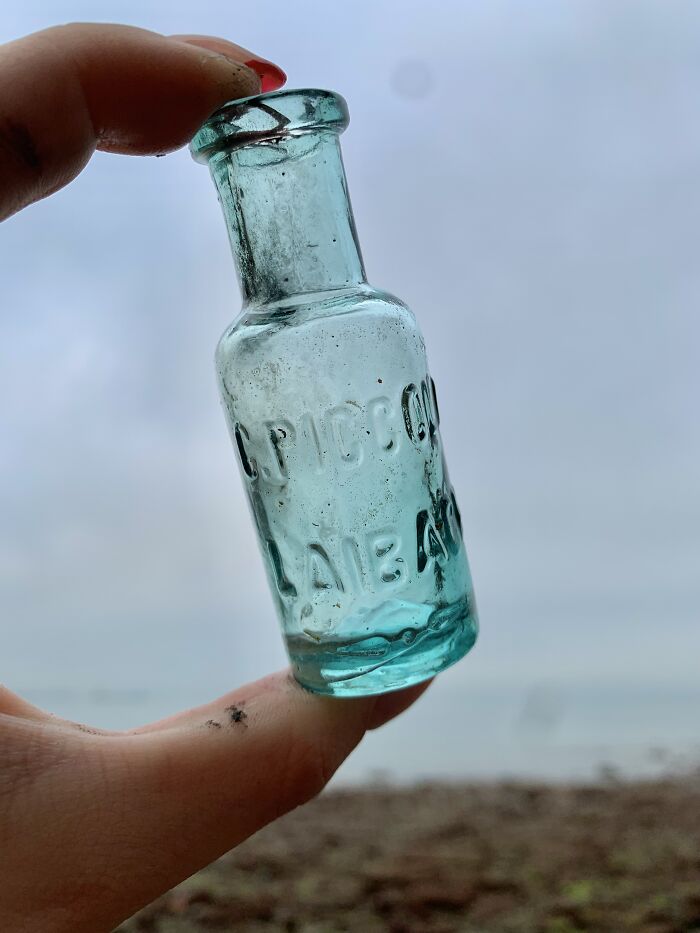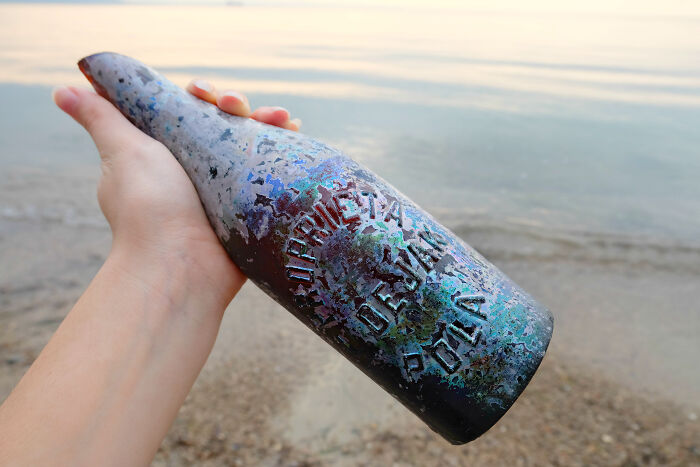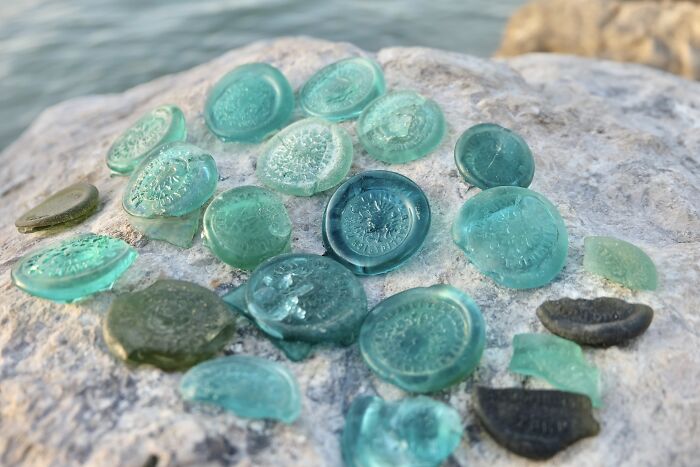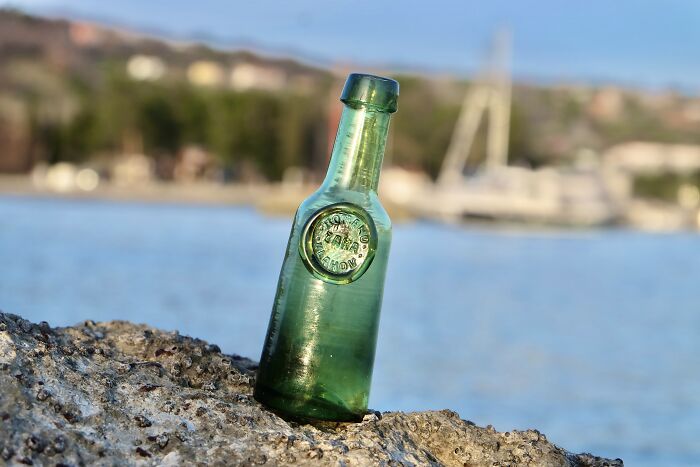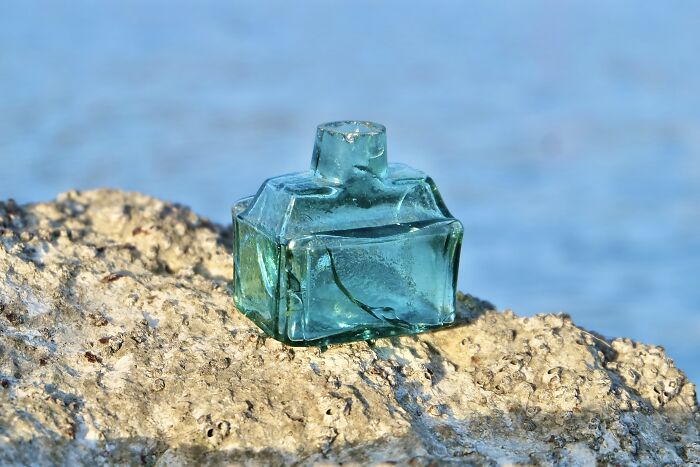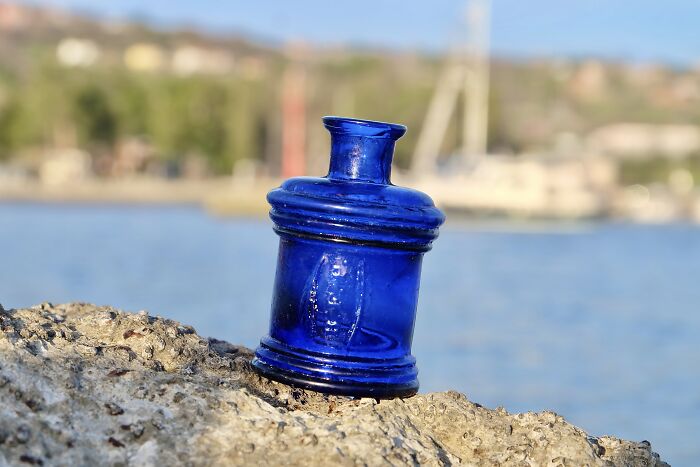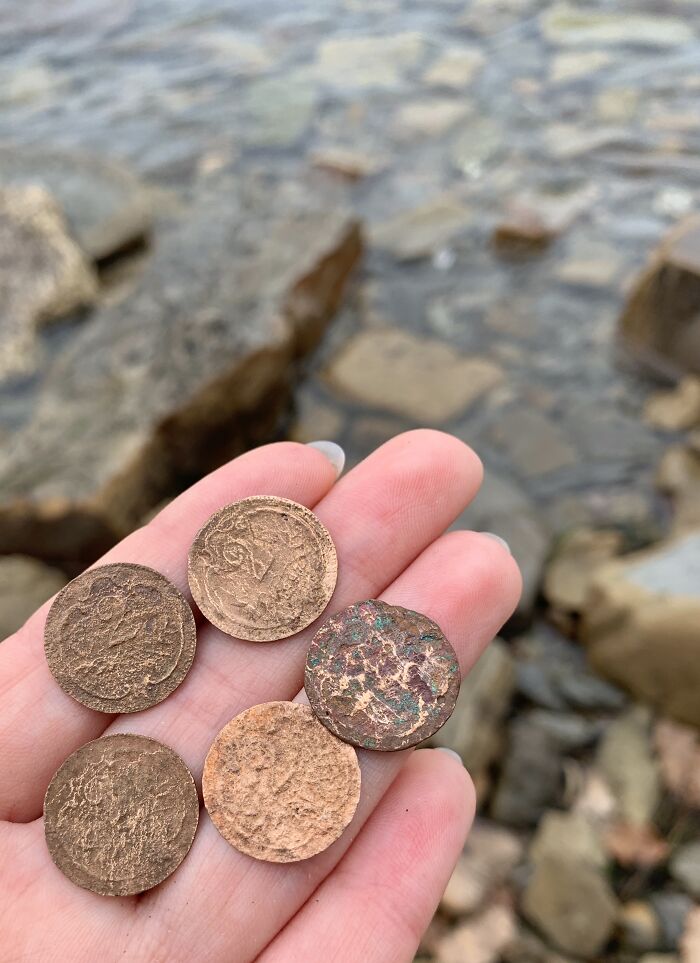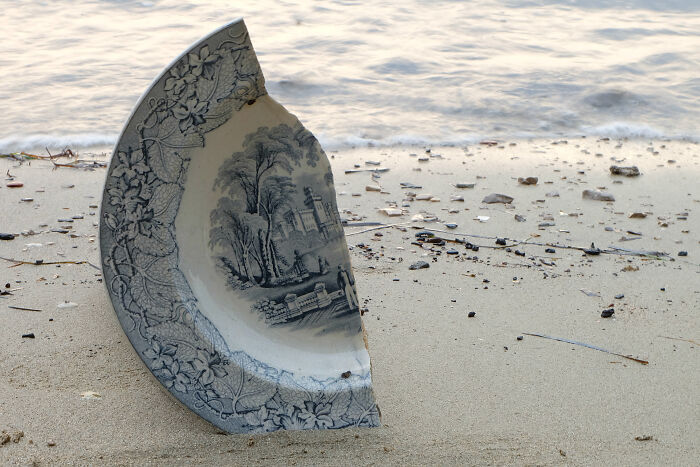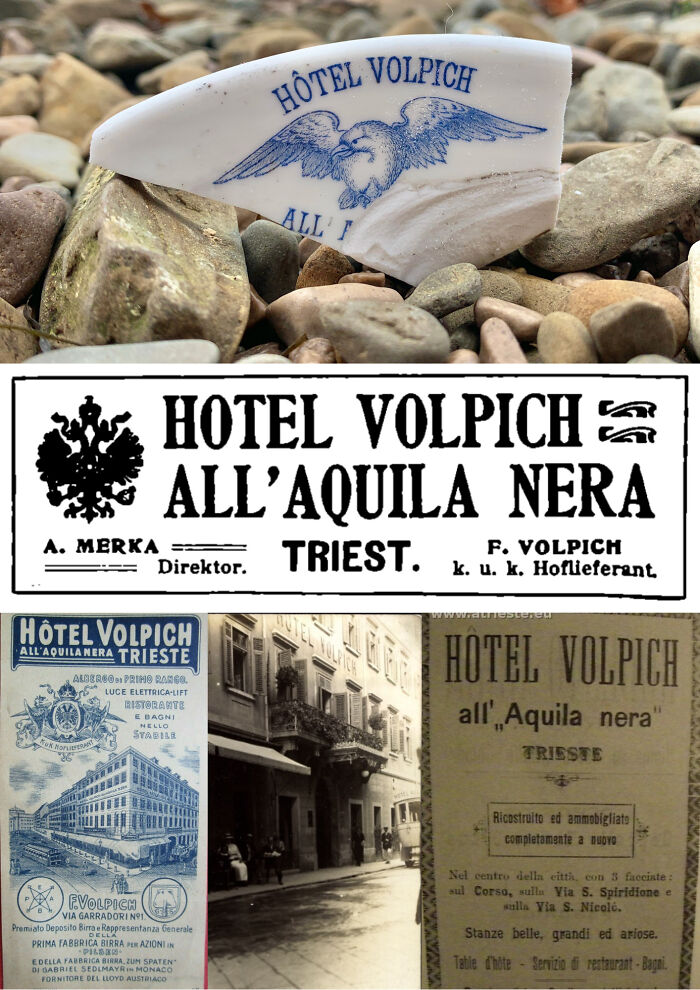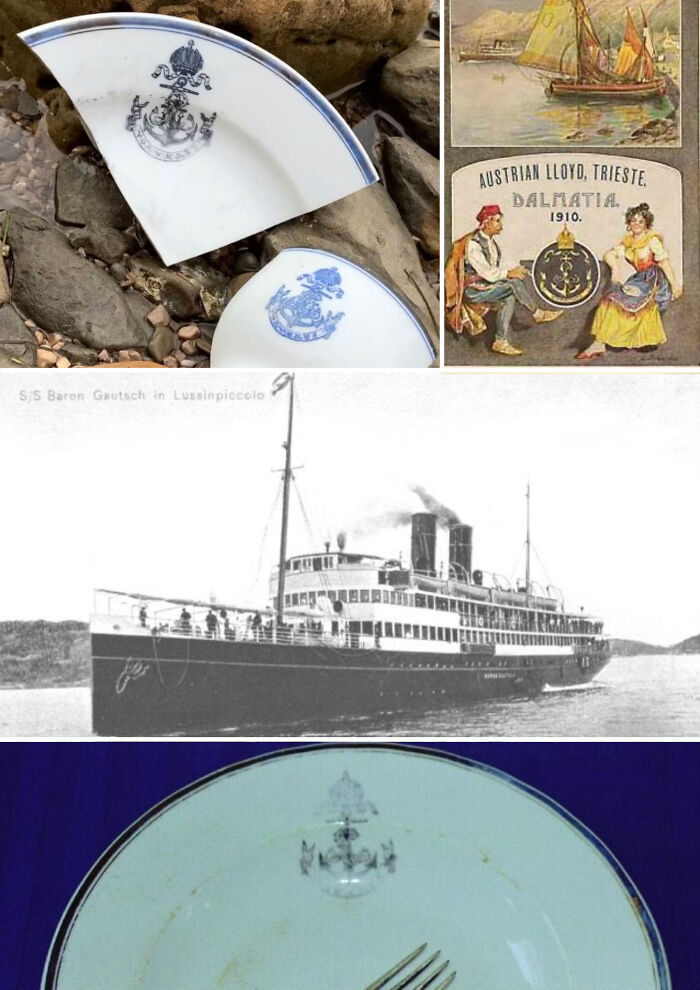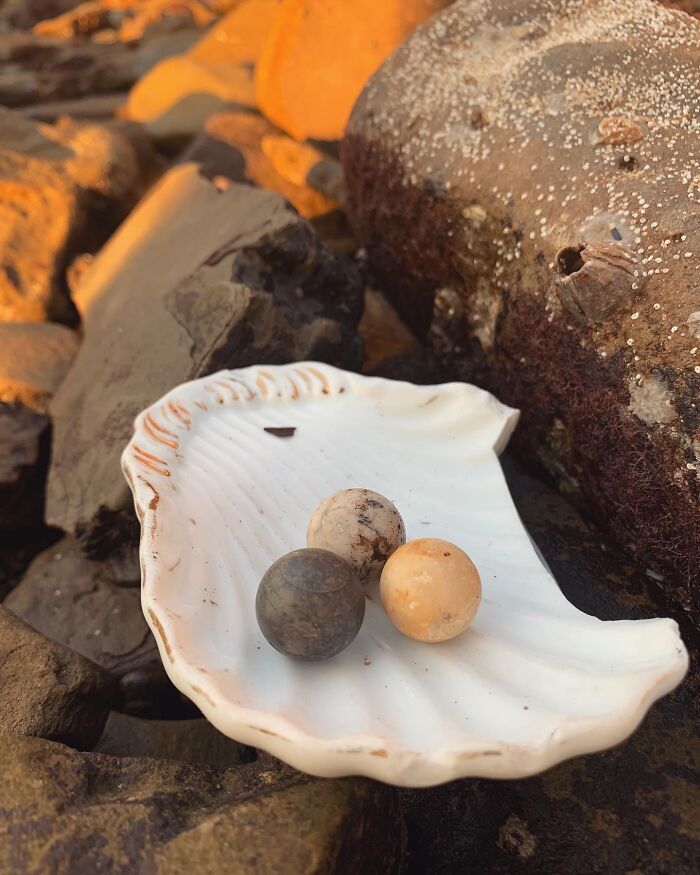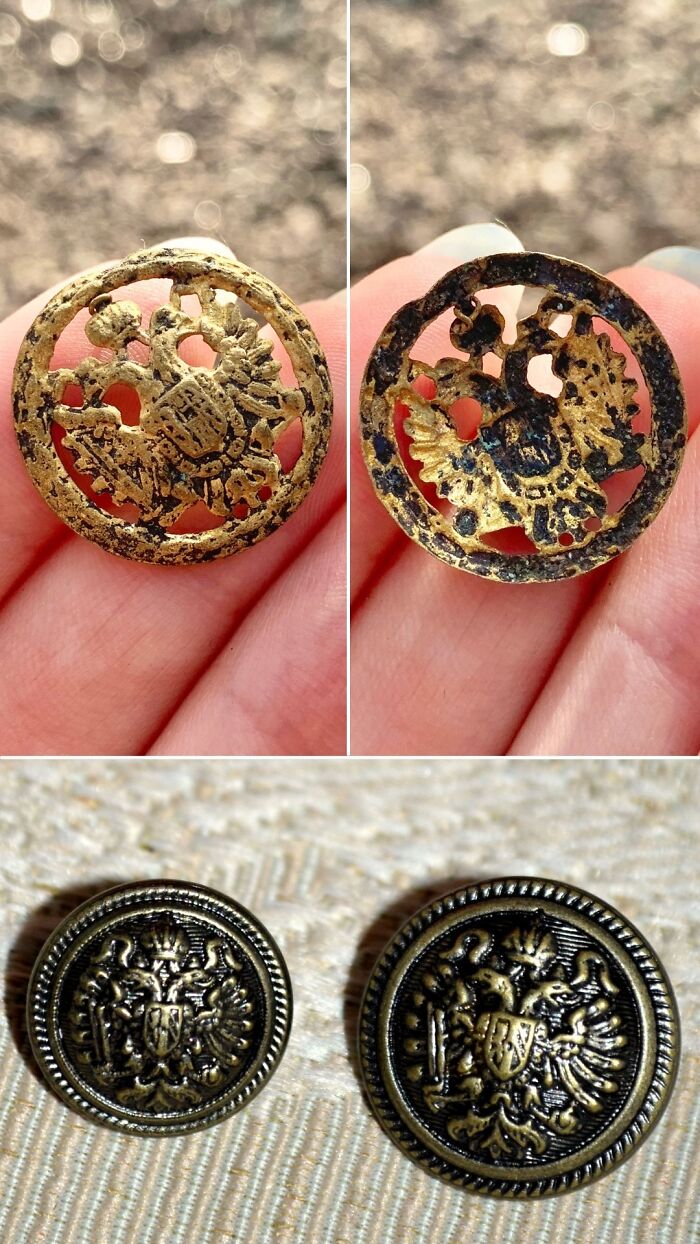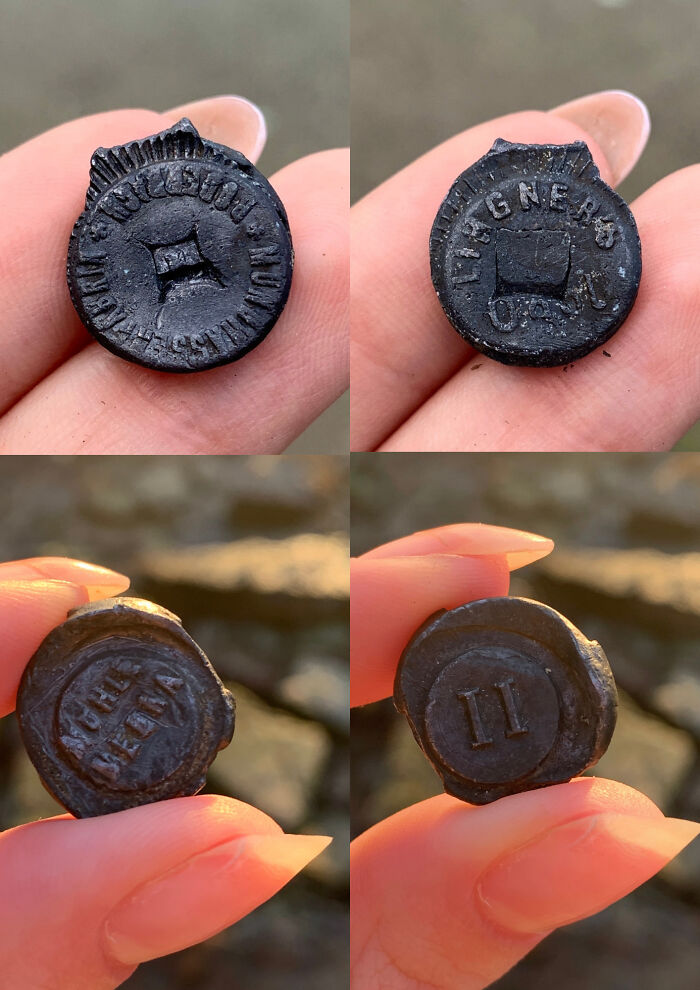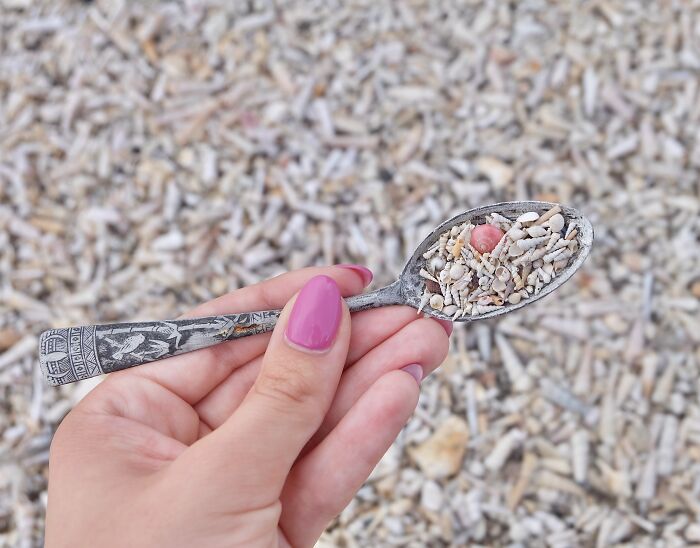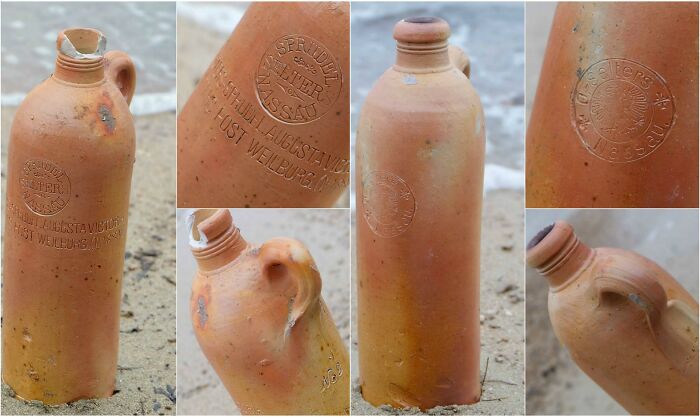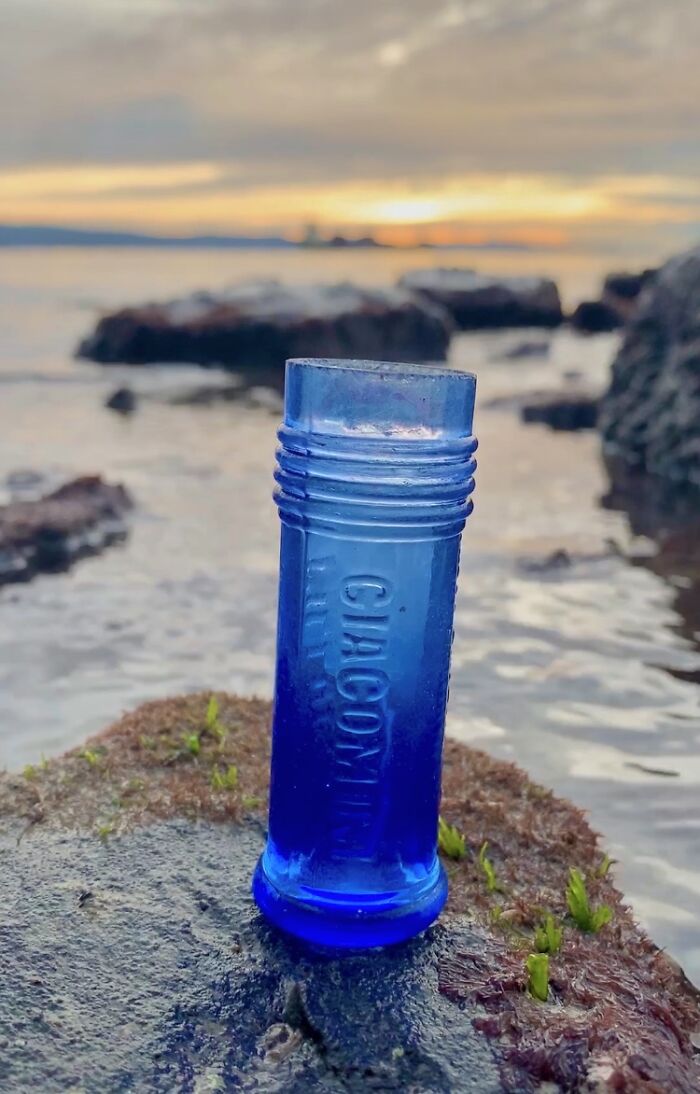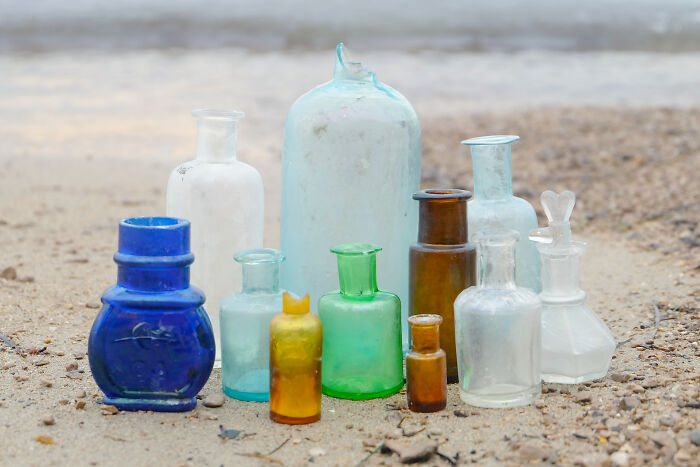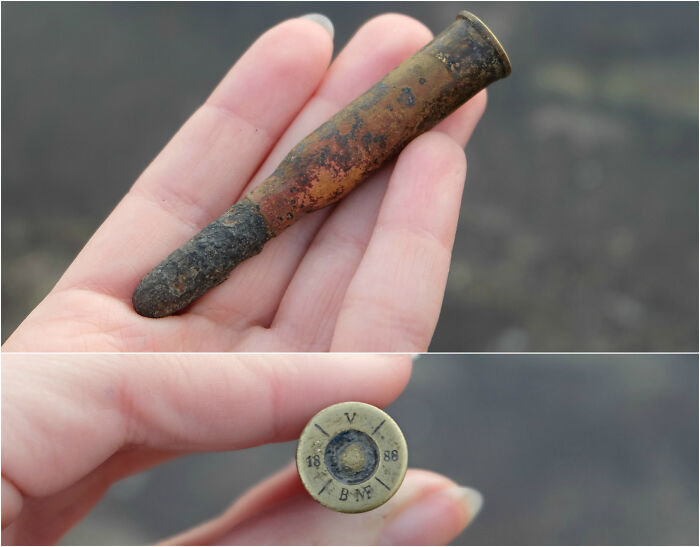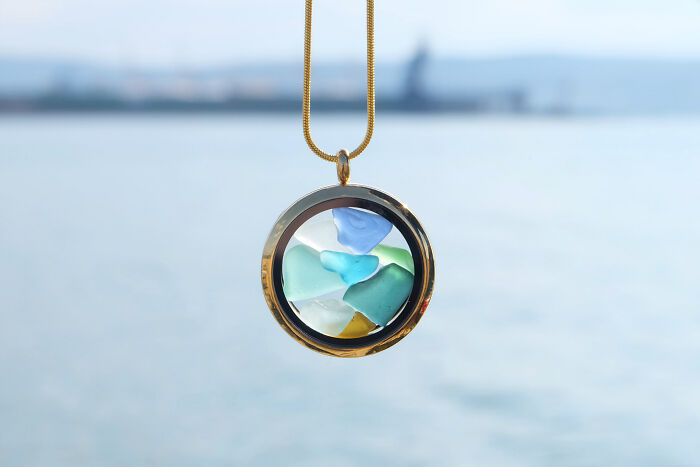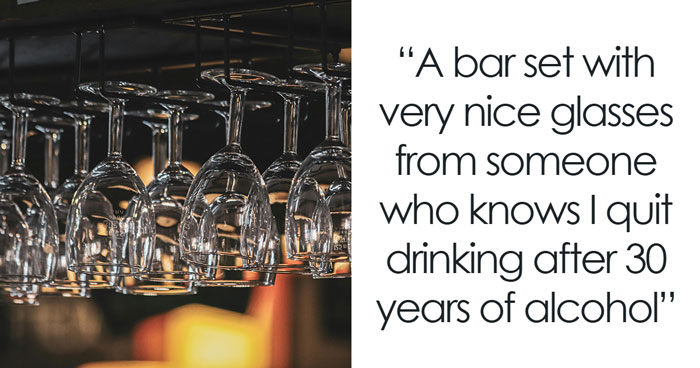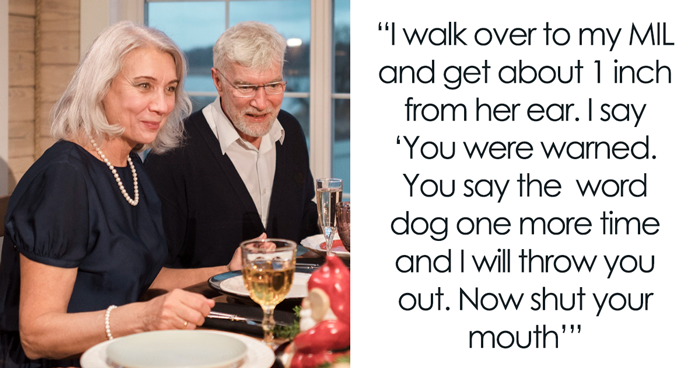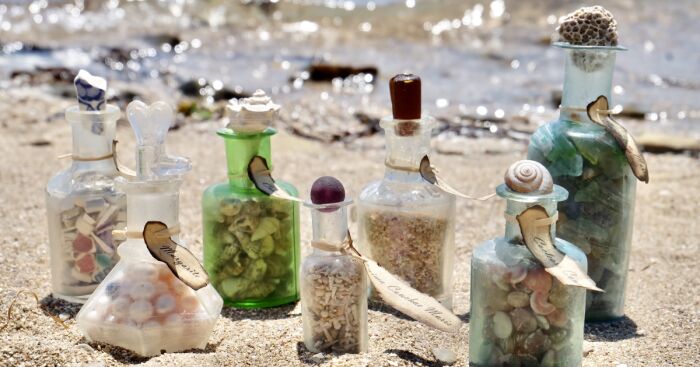
From Trash To Treasure: How One Girl Makes Creations Using Antique Beach-Found Treasures (40 Pics)
Hey there! I'm Marina, a curious student from Ankaran, Slovenia, settled by the Italian border. Living beside the sea has sparked a passion within me for uncovering its hidden treasures.
As I stroll along the shore, my eyes are drawn not just to seashells and driftwood, but to glimmers of glass and bits of ceramics peeking from beneath the sand. Intrigued, I discovered that a century ago, Italian ships left behind remnants of their voyages, now washed ashore by the sea's relentless embrace.
What began as a simple beachcombing hobby evolved into a quest to reclaim these forgotten relics. With each find – whether it's an ancient coin or a shard of sea glass – I'm reminded of the rich history hidden beneath the waves.
Turning these treasures into unique jewelry and suncatchers is my way of honoring the past while celebrating the present. After all, what was once discarded as trash now shines brightly as a testament to the enduring beauty of the sea.
Join me on this journey of discovery, where every piece tells a story and where the sea's bounty knows no bounds. Together, let's uncover the wonders that lie beneath the surface and rediscover the stories of forgotten history through the photos and descriptions of my finds.
Adventure awaits – are you ready to embark on this journey with me, from the comfort of your screen?
More info: Etsy | Instagram | Facebook
This post may include affiliate links.
Beach Treasure Locket Necklace
A clear locket filled with seashells, a starfish, moss, antique sea glass and sea pottery.
Beach Finds Inside Of Beach Finds
Antique beach-found bottles filled with sea treasures.
Tiny Beach Finds
Colorful beach finds - seashells, corals, beach rocks, "sea" glass and "sea pottery".
Antique Black Glass Buttons
Many of the black glass buttons you see were made pre-1918; as a result of Queen Victoria's mourning attire, black was very in vogue.
The Historical Treasures Suncatcher
Introducing our captivating The Historical Treasures suncatcher, a mesmerizing fusion of nature's elegance and history's allure. Crafted with care, this suncatcher features a unique driftwood piece, delicately shaped by nature to reveal a mosaic of treasures from the sea's depths. 𓇼
At its heart lies a vintage Johnson Brothers plate, nearly a century old, depicting the timeless charm of Old Britain Castles. As your gaze traces the water's edge in the painting, it seamlessly merges with the driftwood, symbolizing a harmonious union of sea and shore.
Discover a trove of wonders suspended within: starfish, seashells, and beach stones whisper tales of coastal journeys, while sea glass and pottery whisper stories of past times and untold histories. Among them, a rare turquoise sea glass piece, a stamp from a Luxardo Maraschino bottle, over a century old, originating from the Austro-Hungarian Empire.
Each element tells a story of resilience and transformation, from discarded fragments to cherished treasures, brought together in a symphony of sea beauty and human ingenuity. A testament to the enduring allure of the ocean, this suncatcher is more than just a decoration—it's a conversation starter, a window into the mysteries of the deep, waiting to grace your home with its enchanting presence.
Bottle From The Adriatic "Titanic"
ÖSTERREICHISCHER LLOYD (Italian LLOYD AUSTRIACO) was the biggest shipping company of Austria-Hungary and in the Mediterranean. It was founded in 1833. Its purpose was initially providing information for the participating insurance companies.
From 1836 onwards, the mail service in the Adriatic Sea was also taken over, which laid the foundations for the following expansion in the cargo and passenger area as one of the largest shipping companies in the world.
In 1849, the company launched its flagship Vorwarts (Forward), whose name became its motto. With the opening of the Suez Canal in 1869, the company introduced lines to Mumbai, Colombo, Singapore and Hong Kong.
The passenger ship named Baron Gautsch was one of the most beautiful and modern passenger ships of the Austrian Lloyd. It sailed from the Bay of Kotor on August 12, 1914 on his last, tragic voyage to Trieste, and therefore, given the number of victims, we can call it the Adriatic Titanic. It was less than two weeks after the outbreak of World War I.
On the very next day, the ship sailed too close to the shore into the area of minefields. As soon as the minesweepers noticed that the ship was entering a minefield, they started sending different danger signals, however, there was no reaction from the ship.
At 14.45 a high pillar of the sea rose on the port side of the ship and then a terrible explosion was heard. In the blink of an eye, the sea turned into a terrifying sight of scattered parts of the ship and discarded bodies of passengers floating helplessly and calling for help.
A small part of the assembled crew managed to lower only one of the eight rescue boats. The ship sank in just ten minutes.
Since around 1992, souvenirs from the ship, from silver cutlery to liqueur glasses, have repeatedly appeared on the flea market and in antique shops. The wreck position must have been known to Croatian fishermen, who repeatedly offered divers the opportunity to dive the "Baron Gautsch" - for good payment, but with no guarantee of finding the wreck.
Victorian Art Glass Vase
The Victorian art glass vase is from the second half of the 19th century. It has an applied trail of blue rigaree citrine glass trailing around the vase and a lovely silver design of a branch with flowers, leaves, and acorns.
Tintura D’assenzio - Mantovani Pharmacy
One of the oldest Italian medicines named Tintura d’Assenzio (Tincture – meaning medicine made by dissolving a drug in alcohol, Absinthe - alcohol) from the Girolamo Mantovani Pharmacy in Venice, Italy.
The first traces of this medicine, which was the main remedy against stomach ailments, appeared around the middle of the 17th century. During its 300 years of presence on the shelves, it has been appreciated by many well-known personalities like Napoleon.
The medicine was based on absinthe, distilled water, and ethyl alcohol. It was quite popular, so its creator had to create a sort of "product authenticity seal".
In 1931, in Italy, a law was enacted that placed limits on the sale and distribution of absinthe (but not on pharmaceutical products, including this one), mainly due to the fact that the quantity of absinthe was very scarce in Italy and because Italian alcoholism based its foundations on cheap (and poor quality) liquors.
After World War II, better medicines against stomach pain arrived in Italy against which this medicine couldn't compete anymore.
Natural Mineral Water Roncegno
Since the second half of the 19th century, the natural mineral water Roncegno has been in circulation, loaded with iron and arsenic compounds from the namesake spring near Trento in northern Italy. The brothers Girolamo and Francesco Waiz acquired the right to utilize the spring in 1867. Their business (Dita Fratelli Waiz) constructed the thermal spa in Roncegno in the 1870s and produced therapeutic spring water – Acqua Roncegno.
Since then, the whole region has enjoyed a brief but significant economic boom. The spa was well-known across Austro-Hungarian territories. It was promoted in newspapers at the very beginning of the 20th century, most often with the simultaneous advertising of the healing water Roncegno.
Can You Spot The Bottle?
The bottles sometimes can be hard to spot, especially when they are filled and covered in mud/sea bed. This one was one of the easiest to find.
Can You Spot The Bottle?
Not all bottles can be found this easy. I have most luck when I visit the beach after a storm + low tide. Some treasures will poke out of the sea bed and I have to use some tools to get them out.
Ink Well
Sea Pottery Wrist Watches
Wrist watches filled with bits of antique sea pottery.
"Tea Time" Suncatcher
Featuring antique sea glass and sea pottery treasures along with a starfish and driftwood.
Nail Polish Bottle
Mosto Di Salute
Vito Favara produced cotton, wines, and oil; all repeatedly awarded at Sicilian, national and international exhibitions.
In 1885 Vito Favara together with his brothers and sons, constituted the company “𝐅𝐫𝐚𝐭𝐞𝐥𝐥𝐢 𝐅𝐚𝐯𝐚𝐫𝐚 & 𝐅𝐢𝐠𝐥𝐢” (meaning: Brothers Favara & Sons), in order to work and make the wines suitable for large-scale trade and export. Soon after, the company became the official supplier of the Marsala wine for the Royal House.
𝐓𝐇𝐈𝐒 𝐁𝐎𝐓𝐓𝐋𝐄 𝐅𝐈𝐍𝐃
The writing MOSTO DI SALUTE is referring to the 𝐦𝐮𝐬𝐭 𝐝𝐫𝐢𝐧𝐤 produced by FAVARA factory in Mazara del Vallo (Mazzara in the past) called "𝐅𝐞𝐫𝐫𝐞𝐧𝐨𝐬𝐢𝐨" from the end of 1800 until the beginning of 1900.
Must is freshly crushed fruit juice (usually grape juice) – some call it »𝑦𝑜𝑢𝑛𝑔 𝑤𝑖𝑛𝑒«. This bottle was once filled with the condensed juice from Marsala grapes, which contained significant quantities of iron and phosphorus. The drink provided strength and good health.
The "Ferrenosio" patented by the Favara, was sold in pharmacies in bottles and administered with water or seltzer.
I love drinking “must” but too much of it and you’re stuck to the toilet haha
Melissa Dei C Scalzi
This bottle, with the words "Melissa dei c scalzi" on one side and "Venezia" on the other, is the famous "l’Acqua di Melissa" – healing water made from the Melissa herb. I have contacted the so-called barefoot Carmelite Fathers of the Venetian Province and they have told me that this bottle was made in the early 1800s.
According to the archives, during lunch in the Carmelite convent in Venice a friar wasn't feeling good, so the father helped him not to faint by giving him the water of Melissa to smell. It is claimed to be the first proof of the use of the magical water, made from Melissa Moldavica, distilled from Carmelite religious since 1710. The recipe for the magical water was written in 1841.
What a funny story, I wonder if it really helps or just placebo
Luxardo Maraschino Liquor
This bottle is from around 1880/1890 and was once filled with maraschino liquor made by the family Luxardo, as you can see from the glass stamp. They were one of the most famous families making this liquor and even received many awards for it.
200-Year-Old Cosmacendi Maraschino Bottle
One of my proudest is a 200-year-old undamaged Maraschino bottle from the Austro-Hungarian Empire. After finding it, I returned it back »home« to the Cosmacendi Palace (located in Zadar, Croatia), where the maker of the bottle once lived, and which is now the Museum of Ancient Glass! It was not only an incredible find, but also a bottle without any proof that it even existed. The museum was thrilled to have gotten this amazing piece of history and I was over the moon to have contributed to their collection.
Bottle Of Creme Jris
Creme Jris was made by pharmacist Weiss & Co. from Giessen, Germany. It was filled with a creme used for facecare. It's around 100 years old.
I would have never guessed this was a bottle for skincare. How would you get the cream from the bottom of the bottle
Beach In A Bottle
Glass bottle filled with various beach treasures.
G. Piccoli Laibach
This tiny bottle find with the embossing »G. Piccoli Laibach« is from the Gabriel Piccoli Pharmacy in Ljubljana, Slovenia (Laibach during the Austria-Hungary times) that operated from 1873 to 1946.
Mag. pharm. Gabriel Picolli (born 1850 in Rovinj, Croatia graduated in 1873 in Graz, Austria) bought the pharmacy "pri Angelu" (meaning »at the Angel«) in Ljubljana in 1873.
His son (of the same name) inherited the pharmacy. The pharmacy was known for its solid service, with which it gained regular customers. With the purchase of modern machines, it constantly adapted to the requirements of that time.
Whyy are all these so cute! I wonder how expensive medicine was back in the day
Beer Bottle
This bottle with the words "Proprieta' L. Dejak Pola" was from a gentleman named Luigi Dejak. He was mostly known for his beer and wine in Pola at the end of the 19th century. His wine received many prizes around Europe for its amazing flavor and quality. This specific bottle was filled with beer.
Collection Of Stamps From Maraschino Liquor
Each Maraschino liquor maker had a stamp on his bottle. The stamp usually had the two headed eagle representing the Austro-Hungarian Empire and the makers surname.
Interesting that almost all of the choose a similar color, do you know why?
Vlahov Elixir
Romano Vlahov started making his first liqueurs in the early 1860s. He founded his first liqueur factory in the city of Šibenik (Sebenico during the Austro-Hungarian Empire) in 1867, and twenty years later in Zadar (Zara), where he became world-renowned for his numerous liqueurs, especially maraschino.
For several years he had been battling a slow illness accompanied by fever. He sought a cure everywhere, but to no avail.
Franciscan Smoje from Split recommended one of his elixirs (liquid used for medical purposes).
Vlahov started taking it, and it helped him. He perfected the recipe with other ingredients, and after a few months, he was completely cured.
And exactly this digestive liqueur (digestif) was inside this 19th-century bottle.
Even today, many, especially after a large meal to facilitate digestion, like to drink "Vlahov" (now under the name "Vlahovac").
It’s so cute and tiny, I wish nowadays medicine was packaged this cute, I would drink it easily 🤣
Ink Well
Ink well with a spot to rest your pen.
A lovely color! I would have never guessed it was an ink bottle
B. F. P. Bottle
This cobalt blue bottle is shaped like a lot of ink wells I found but this one has an embossing "B. F. P." and I still haven't found any information on it.
120+ Year Old Coins
These are "Hellers" from the Austro - Hungarian Empire. On one side there’s a double-headed eagle, on the other side the number 2 and the year it was made. On one piece you can see the year 1897! In Austria-Hungary, Heller was the term used in the Austrian half of the empire for 1/100 of the Austro-Hungarian krone (the other being fillér in the Hungarian half), the currency from 1892 until after the demise (1918) of the Empire.
I wonder how much is this in nowadays time? Were you rich if you had these coins?
Half Of A French Plate From The 1860s
On the back it has half of a stamp of a French maker.
I wonder what’s on the other broken side, a princess next to this gentleman? Have you ever found the other side?
Italian Hotel Plate
This piece was probably once a part of a plate from a hotel named Hotel Volpich all' »Aquila nera« (black eagle).
It was an inn (a small hotel, providing accommodation, food, and drink, especially for travellers) located in Trieste, Italy.
It became Hotel Volpich in 1896 when it was led by Francesco Volpich. These were the golden years (until 1918).
After the allied invasion of Italy in 1943, the hotel became Hotel Milano and shortly after Hotel Corso. The current owner of the building is Lloyd Adriatico (since 1964) who in 1980 decided on another use of the property.
Interesting, I love this pictures you attached, it’s easier to imagine
A Plate And A Cup From The Adriatic "Titanic"
ÖSTERREICHISCHER LLOYD (Italian LLOYD AUSTRIACO) was the biggest shipping company of Austria-Hungary and in the Mediterranean. It was founded in 1833. Its purpose was initially providing information for the participating insurance companies.
From 1836 onwards, the mail service in the Adriatic Sea was also taken over, which laid the foundations for the following expansion in the cargo and passenger area as one of the largest shipping companies in the world.
In 1849, the company launched its flagship Vorwarts (Forward), whose name became its motto. With the opening of the Suez Canal in 1869, the company introduced lines to Mumbai, Colombo, Singapore and Hong Kong.
The passenger ship named Baron Gautsch was one of the most beautiful and modern passenger ships of the Austrian Lloyd. It sailed from the Bay of Kotor on August 12, 1914 on his last, tragic voyage to Trieste, and therefore, given the number of victims, we can call it the Adriatic Titanic. It was less than two weeks after the outbreak of World War I.
On the very next day, the ship sailed too close to the shore into the area of minefields. As soon as the minesweepers noticed that the ship was entering a minefield, they started sending different danger signals, however, there was no reaction from the ship.
At 14.45 a high pillar of the sea rose on the port side of the ship and then a terrible explosion was heard. In the blink of an eye, the sea turned into a terrifying sight of scattered parts of the ship and discarded bodies of passengers floating helplessly and calling for help.
A small part of the assembled crew managed to lower only one of the eight rescue boats. The ship sank in just ten minutes.
Since around 1992, souvenirs from the ship, from silver cutlery to liqueur glasses, have repeatedly appeared on the flea market and in antique shops. The wreck position must have been known to Croatian fishermen, who repeatedly offered divers the opportunity to dive the "Baron Gautsch" - for good payment, but with no guarantee of finding the wreck.
Clay Marbles
Antique clay marbles, a popular Victorian toy - dating from the 1800s.
These are much more common to find than glass marbles because they were easier to make and more affordable.
Omg, they look like tiny eggs 🥚 I had only glass ones growing up
100 Year Old (Part Of A) Button From The Austro-Hungarian Empire Times
Lead Bale/Cloth Seals
Lead seals were affixed to goods to communicate information such as place of origin, manufacture, quality, size, circulation, and taxation. Lead seals are the colonial equivalent to today’s merchandise tag. Most commonly associated with textiles, lead seals marked everything from tobacco and salt to bundles of various trade goods. Easily molded, a lead seal was affixed to a bale of goods at its place of origin (typically somewhere in Europe) and remained unmolested until the goods reached their final destination. They were used from the 17th to the 19th century.
Vintage Spoon
Natural Mineral Water Selters
This stoneware bottle contained natural mineral water sourced from a naturally carbonated spring Selters located in Niederselters, Germany.
This spring was the best-known in Germany, and waters were exported worldwide during the 18th and 19th centuries. The bottles were manufactured in the Westerwald Mountains, known as the “jug baking land/district.”
This bottle is from a German company named OberSelters that even today sells mineral water (produced in Nassau, Germany).
Mineral water has been known as a natural soda water because of its high concentration of sodium bicarbonate, “soda”. Selters water also contains raised levels of calcium, chloride, magnesium, sulfate and potassium ions.
The stamp on this bottle (a German eagle surrounded with the words »Ober-Selters Nassau«) was used only on bottles made from 1836 to 1866.
Under the handle of each bottle is stamped the first initial of the jug maker’s location (I have always found the letter M) and their individual number.
Giacomini Pills
Cobalt blue glass bottle with the words »GIACOMINI«, »PILLOLE« AND »ANTI-EMORROIDALI«. The bottle contained treatment pills for hemorrhoid problems, as highlighted in relief on the outer wall of the package (ANTI-EMORROIDALI).
GIACOMINI is the name of one of the most important scientists in the first half of the 19th century in Italy and a university professor in Padua - Giacomo Andrea Giacomini.
Giacomini pills are also mentioned in the list of medicinal, medical, chemical, cosmetic, and various other approved products from 1890 in Italy and major European capitals.
At that time, for 50 years since prof. Giacomini registered the prescription pills, the right of distribution had the pharmacy Pianeri e Mauro located in the heart of Padua.
The bottle was made dark blue so the contents were protected from daylight.
Different Bottle Finds
Most of them are pharmaceutical bottles once filled with medicine. Some don't have any markings while some have a number on the bottom (meaning how many millilitres were inside).
Rifle Bullet
The 8×52mmR Mannlicher cartridge was first introduced in 1888 for the Mannlicher M1888 rifle. It was made in and also used by the Austro-Hungarian Empire from 1888 to 1890.
Sea Glass Locket
Amazing finds and information. You found a jackpot 🎰. Thank you for sharing.
Thank you so much for your kind words. Happy to share ❤️
Load More Replies...Amazing finds and information. You found a jackpot 🎰. Thank you for sharing.
Thank you so much for your kind words. Happy to share ❤️
Load More Replies...
 Dark Mode
Dark Mode 

 No fees, cancel anytime
No fees, cancel anytime 






